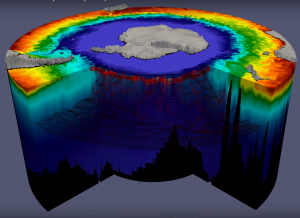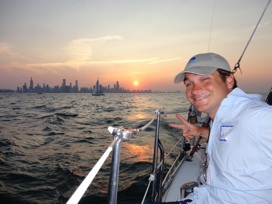story by Helen Hill


Southern Ocean temperature (SOSE) – click on the image to see the movie by Uriel Zajaczkovski; http://pordlabs.ucsd.edu/uriel/
This month we spotlight work by Michael Kosempa and Don P. Chambers from the College of Marine Science at the University of South Florida who have been using MITgcm in a study assessing mapping error in Southern Ocean transport computed from satellite altimetry and Argo float data.
Motivated by a desire to better estimate transport dynamics in response to wind forcing (primarily the Southern Annual Mode), the Kosempa and Chambers study seeks to quantify the uncertainty in mapping the zonal geostrophic transport of the Antarctic Circumpolar Current from the sparse temperature, salinity and sea surface height observations.
The Southern Ocean State Estimate (SOSE), a general circulation model solution obtained from the MITgcm, assimilates available ocean observations (including altimetry and Argo float data) using a least squares estimation technique, with a solution optimized from initial and boundary conditions over the Southern Ocean.

When not working on the ACC, Kosempa says he enjoys community and competitive sailing and marlin spike artwork. He also enjoys bird watching and is keen to finish his airplane pilots license. “I try to stay active in my local yacht club, St Petersburg YC and also the local Toastmasters International Club, Toast of the Bay, Club 4145.” Other ventures include developing Android smartphone applications designed for publishing audio visual material to support better communication. Kosempa will defend his dissertation in February 2017.
Kosempa and Chambers sampled SOSE at the locations of both Argo floats and the Jason-1 altimeter groundtrack. They then optimally interpolated these sampled values to create SSH and temperature/salinity grids with 1° resolution. Combining the temperature, salinity and SSH grids to compute the zonal geostrophic transport the pair then compare it to that estimated from the full state estimate.
Among their findings, Kosempa and Chambers note significant correlations between the baroclinic and barotropic error contributions to the total transport error. They find the increase in Argo floats in the Southern Ocean is effective in reducing mapping error but that error improvement is not uniform. By analyzing systematic errors in transport time series, they are able to identify which transects are most appropriate for analyzing the dynamics of ACC transport using Argo and altimetric gridded fields. Based on their analysis, the pair conclude that the region south of Tasmania is most appropriate, exhibiting lowest uncertainty. Using real-world data, they then calculate zonal transport variability at a transect south of Tasmania where they find an insignificant trend (0.3 ± 0.4 Sv yr−1, 90% confidence) but significant low-frequency variability correlated with the Southern Annular Mode (0.53, p < 0.05). They determine that the barotropic component is most responsible for the low-frequency variability but note this would be unobservable from ship casts without velocity measurements at depth.
To find out more about this work contact Michael
This Month’s Featured Publication
- Michael Kosempa, Don P. Chambers (2016), Mapping error in Southern Ocean transport computed from satellite altimetry and argo, online at Journal of Geophysical Research – Oceans, doi:10.1002/2016JC011956
Other New Publications this Month
Amrhein, Daniel E. (2016), Inferring ocean circulation during the Last Glacial Maximum and last deglaciation using data and models, MIT-WHOI Doctoral Dissertation, http://hdl.handle.net/1912/8428
Adam S. Candy, Matthew D. Piggott, Paul R. Holland, Satoshi Kimura, Adrian Jenkins (2016), Pine Island Glacier ice shelf melt distribution modelled at basal channel scales, enabled by unstructured mesh approaches, IMUM 2016, 15th International Workshop on Multi-Scale (Un)-structured Mesh Numerical Modeling for coastal, shelf, and global ocean dynamics, Toulouse, France, September 27-29, 2017 pdf
David S. Amundsen, Pascal Tremblin, James Manners, Isabelle Baraffe, and Nathan J. Mayne (2016), Treatment of overlapping gaseous absorption with the correlated-k method in hot Jupiter and brown dwarf atmosphere models, Astronomy and Astrophysics, arXiv: https://arxiv.org/pdf/1610.01389.pdf
Sarah Gille, Bia Villas Bôas, Bruce Cornuelle, Mathew Mazloff (2016), Assimilation and Interpretation of High-Wavenumber Variability in the Ocean for SWOT, Scripps Institution of Oceanography, UCSD poster
Ali Harzallah, Gabriel Jordà, Clotilde Dubois, Gianmaria Sannino, Adriana Carillo, Laurent Li, Thomas Arsouze, Leone Cavicchia, Jonathan Beuvier, Naveed Akhtar (2016), Long term evolution of heat budget in the Mediterranean Sea from Med-CORDEX forced and coupled simulations, Climate Dynamics, doi: 10.1007/s00382-016-3363-5
Madhu Joshi, Ambarukhana Devendra, RaoSachiko, MohantyHimansu, Kesari Pradhan, Vadlamani S. N. Murty, Koneru Venkata Siva Rama Prasad (2016), Internal waves over the shelf in the western Bay of Bengal: a case study, online at Ocean Dynamics, doi: 10.1007/s10236-016-1006-3
Lars Nerger, Paul Kirchgessner, Wolfgang Hiller (2016), Building Ensemble-Based Data Assimilation Systems for High-Dimensional Models with the Parallel Data Assimilation Framework PDAF, Workshop on Terrestrial Data Assimilation, Bonn, 19. – 21.9.2016 pdf
Etienne Pauthenet, Fabien Roquet, Gurvan Madec, David Nerini (2016), A linear decomposition of the Southern Ocean thermohaline structure, Journal of Physical Oceanography, doi: 10.1175/JPO-D-16-0083.1
Jaroslaw Piwonski and Thomas Slawig (2016), Metos3D: the Marine Ecosystem Toolkit for Optimization and Simulation in 3-D – Part 1: Simulation Package v0.3.2, Geosci. Model Dev., 9, 3729–3750, doi: 10.5194/gmd-9-3729-2016
R.E. Ross (2016), Investigating the role of larval dispersal models in the development of an ecologically coherent network of deep sea marine protected areas, PhD Thesis, Plymouth University, School of Marine Science & Engineering, pdf
J. C. B. da Silva, J. M. Magalhaes (2016), Internal solitons in the Andaman Sea: a new look at an old problem, Proc. SPIE 9999, Remote Sensing of the Ocean, Sea Ice, Coastal Waters, and Large Water Regions 2016, 999907 (October 19, 2016); doi: 10.1117/12.2241198
Pradhan, H. K.,Völker, C., Losa, S. N. and Nerger, L. (2016): Assimilation of OC-CCI data for parameter estimation in the coupled ocean biogeochemical model MITgcm-REcoM, Colour and Light in the Ocean from Earth Observation (CLEO), ESA Centre for Earth Observation (ESRIN), Frascati, Italy, 6 September 2016 – 8 September 2016, hdl: 10013/epic.48619
H. R. Wakeford, C. Visscher, N.K. Lewis, T. Kataria, M.S. Marley, J.J. Fortney, and A.M. Mandell (2016), High temperature condensate clouds in super-hot Jupiter atmospheres, https://arxiv.org/pdf/1610.03325.pdf
Lian, Yuan; Newman, Claire E.; Richardson, Mark I. (2016), The atmospheric circulation and methane cycle in the TitanWRF and Titan MITgcm models, American Astronomical Society, DPS meeting #48, id.#424.01, http://adsabs.harvard.edu/abs/2016DPS….4842401L
Liu Tongya, Xu Jiexin, He Yinghui, L Haibin, Yao Yuan, Cai Shuqun (2016), Numerical simulation of the Kuroshio intrusion into the South China Sea by a passive tracer, doi: 10.1007/s13131-016-0930-x
Xiangming Zeng, Ruoying He (2016), Gulf Stream variability and a triggering mechanism of its large meander in the South Atlantic Bight, online at Journal of Geophysical Research – Oceans, doi: 10.1002/2016JC012077
Zube, Nicholas Gerard; Zhang, Xi; Natraj, Vijay (2016), Evaluation of the efficiency and accuracy of new methods for atmospheric opacity and radiative transfer calculations in planetary general circulation model simulations, American Astronomical Society, DPS meeting #48, id.#403.01, http://adsabs.harvard.edu/abs/2016DPS….4840301Z
Do you have news about research using MITgcm? We are looking for contributions to these pages. If you have an interesting MITgcm project (ocean, atmosphere, sea-ice, physics, biology or otherwise) that you want to tell people about, get in touch. To make a post, contact Helen
